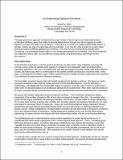| dc.description.abstract | This paper presents an approach to determine the proper number of levels required on independent product architectural attributes, given their ability to generate added revenue through more direct targeting to smaller segments, and given the added costs of doing so. This is done in as simple and readily implementable manner as
possible, making use only of conjoint data and cost estimates. From this, the order in which to consider added breakouts across the different attributes are prioritized. From this, for any minimum level of profit worth considering, a set of attribute levels to offer on each architectural attribute can be selected. Then, for any selected set of attribute levels to offer, the most effective product family using those levels is determined from the permutations. | en |
